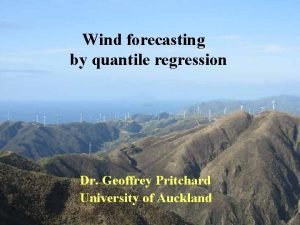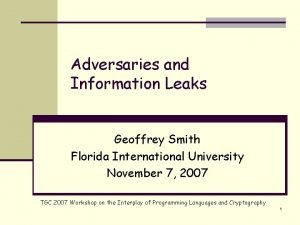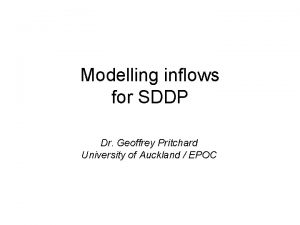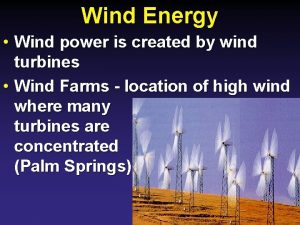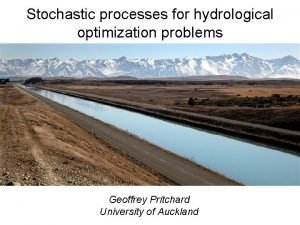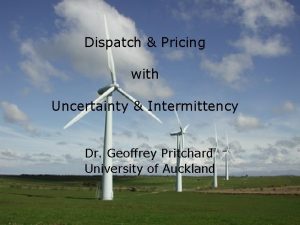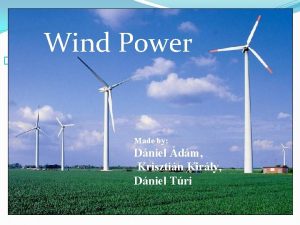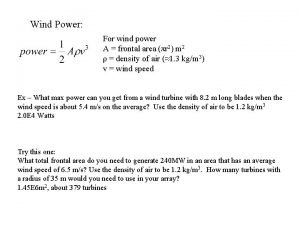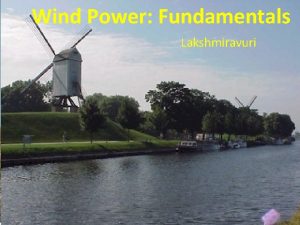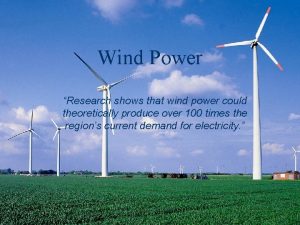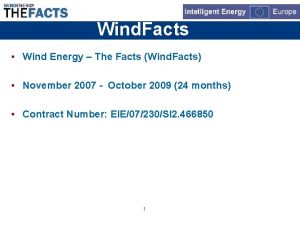Wind Power Grid Operation Dr Geoffrey Pritchard University

















![Stochastic dispatch problem minimizex E[ c(x, W) ] (dispatch decision) (random wind/load outcome) (Expected Stochastic dispatch problem minimizex E[ c(x, W) ] (dispatch decision) (random wind/load outcome) (Expected](https://slidetodoc.com/presentation_image_h2/8a7153f336be15cd4cd619233669b832/image-18.jpg)











- Slides: 29

Wind Power & Grid Operation Dr. Geoffrey Pritchard University of Auckland

Wind forecasting • Generation dispatched 2 hours in advance of real time. Forecasts used for loads, wind. • Re-dispatch / frequency-keeping required when forecasts turn out to be wrong. • Need to understand probability distribution of forecast error.

Centralised Data Set • Electricity Commission data. • Includes half-hourly metered output by all power stations, including wind farms. • Useful data for – – Tararua I (4 years), I+II (3. 8 years), III (8 months) Te Apiti (3. 4 years) Hau Nui (2 years) White Hill (6 months)



Unforecasted component of wind • The relevant quantity for grid operation is Unforecasted output = (actual output) – (forecast output) • Forecast is usually simple persistence forecast no change). (i. e.

Simple persistence forecast @ -2 hr TP-5 0 TP-4 TP-3 • Generator offers close • Wind forecast is actual output in TP-5 TP-2 TP-1 +30 min TP • Actual wind observed Unforecasted wind in TP = (output in TP) – (output in TP-5)




Scenario selection problem • NZ wind farms: 6 -30 distinct sites • Need a tractable collection of model scenarios for unforecasted wind at all sites • Historical data: too many/too few scenarios

Example: 2 sites Reduce the following to 5 model scenarios:

Example: 2 sites Reduce the following to 5 model scenarios:

2 sites, transmission unconstrained Only the total unforecasted output matters – so we really have only 3 scenarios

2 sites, transmission unconstrained An improvement – 5 different scenarios

Optimal dispatch problem (SPD) Generators offer to sell tranches qi, asking prices pi We find dispatches xi to minimize S pi x i (cost of power, at offered prices) so that – (forecast) demand is met – transmission network is operated within capacity – 0 < x i < qi

Deterministic dispatch problem minimizex c(x) (dispatch decision) (Cost of dispatch, valuing power at offered prices. )
![Stochastic dispatch problem minimizex E cx W dispatch decision random windload outcome Expected Stochastic dispatch problem minimizex E[ c(x, W) ] (dispatch decision) (random wind/load outcome) (Expected](https://slidetodoc.com/presentation_image_h2/8a7153f336be15cd4cd619233669b832/image-18.jpg)
Stochastic dispatch problem minimizex E[ c(x, W) ] (dispatch decision) (random wind/load outcome) (Expected cost of dispatch and re-dispatch. )

Example Thermal B: 100 @ $45 Wind B: 60 @ $0 Wind A: 60 @ $0 Hydro: 50 @ $42 60 @ $80 Thermal A: 100 @ $40 capacity 150 Load 264 Wind farm offers are forecasts only.

Dispatch solution Thermal B: 100 @ $45 45 Wind A: 60 @ $0 60 60 Thermal A: 100 @ $40 69 30 145/150 Load 264 (different from the standard optimal dispatch) Wind B: 60 @ $0 Hydro: 50 @ $42 60 @ $80




Wasserstein distance Distance between a true probability distribution m and a model-scenario representation n: d. W(m, n) = Em[ distance to nearest model scenario ]

Wasserstein distance • Wasserstein approximations are good for stochastic optimization in general, i. e. devoid of the context of a particular problem. • Can adapt it for a more specific class of problems by re-defining the distance between scenarios.


A way forward? • First solve the dispatch problem using only forecast wind (SPD). • Then generate relevant model scenarios for unforecasted wind at all sites. • Now re-solve allowing for re-dispatch costs created by the model scenarios (robust solution).

Wind Power & Grid Operation Dr. Geoffrey Pritchard University of Auckland

NZ has a large wind resource • 500 MW now installed or under construction – many more sites under investigation or seeking consents. • 3000+ MW potential – but this ignores system integration issues.
 Geoffrey pritchard
Geoffrey pritchard Emergncia
Emergncia Ivor pritchard
Ivor pritchard Margaret pritchard houston
Margaret pritchard houston Margaret pritchard houston
Margaret pritchard houston Rosalind pritchard
Rosalind pritchard Zuspan regimen
Zuspan regimen Pritchard capital partners
Pritchard capital partners Raumschotkurs
Raumschotkurs Maj. buang-ly
Maj. buang-ly Draw power triangle
Draw power triangle Land grid array vs pin grid array
Land grid array vs pin grid array Performer heritage geoffrey chaucer
Performer heritage geoffrey chaucer Geoffrey moore’s template
Geoffrey moore’s template Geoffrey brown nsf
Geoffrey brown nsf Geoffrey leech 7 types of meaning
Geoffrey leech 7 types of meaning Geoffrey bawa awards
Geoffrey bawa awards Geoffrey royce
Geoffrey royce Geoffrey beattie interruptions
Geoffrey beattie interruptions Geoffrey ye li
Geoffrey ye li Geoffrey gustavsen
Geoffrey gustavsen Cpsc 259
Cpsc 259 Cpsc 221
Cpsc 221 Geoffrey tien
Geoffrey tien Geoffrey brown iu
Geoffrey brown iu Geoffrey curran
Geoffrey curran Dr geoffrey cohen
Dr geoffrey cohen Professor geoffrey smith fiu
Professor geoffrey smith fiu Geoffrey chaucer notes
Geoffrey chaucer notes Geoffrey hamilton unece
Geoffrey hamilton unece
